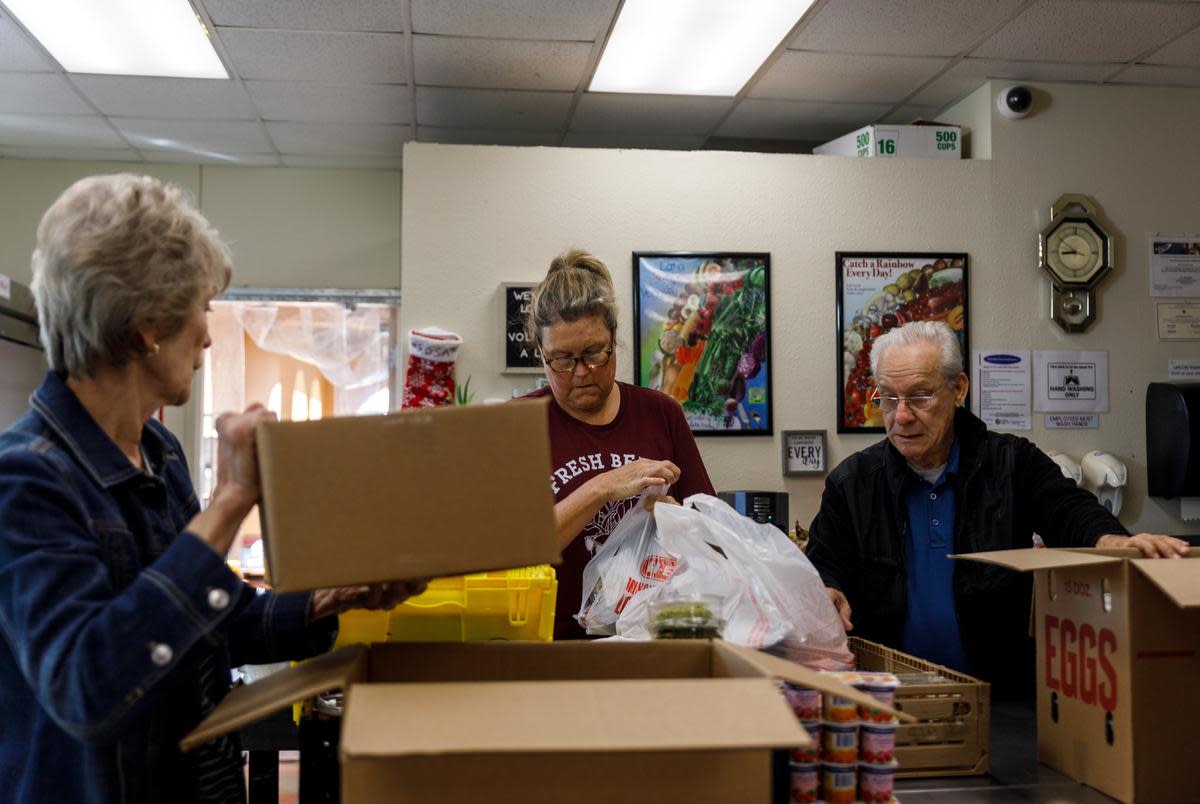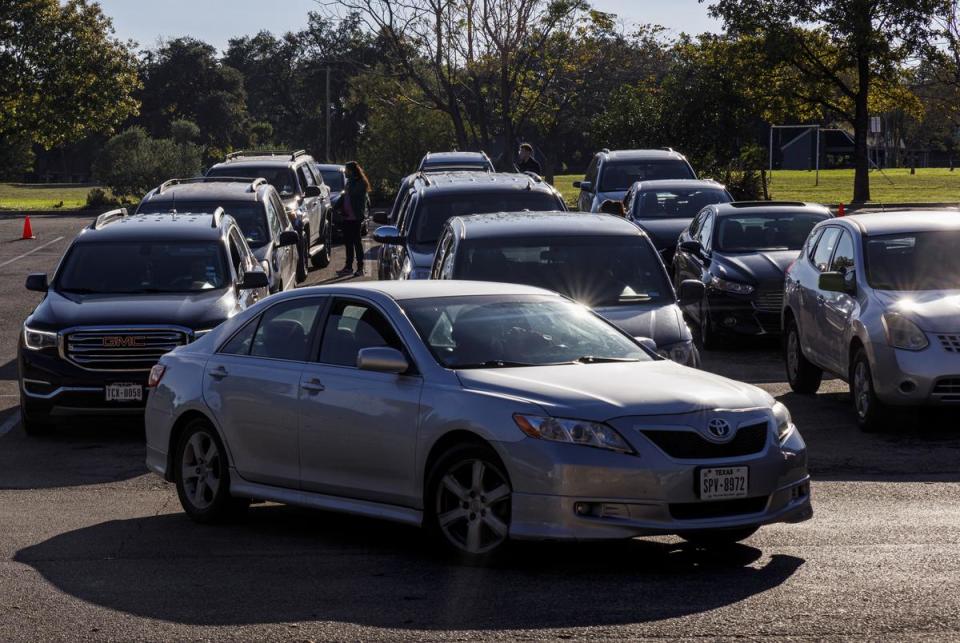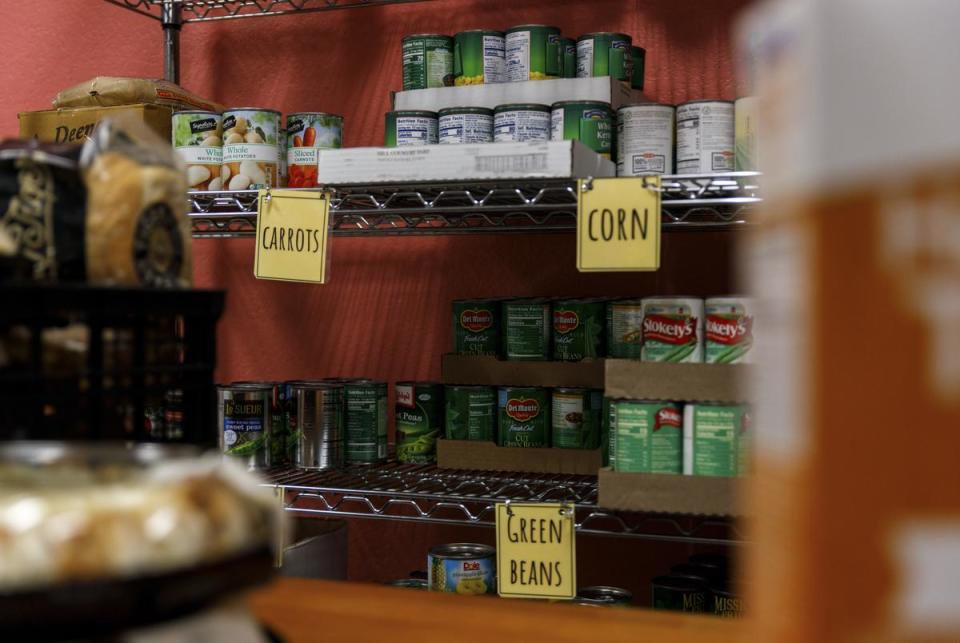“How long can we keep this up?” Food banks are under pressure from Texas’ high level of food insecurity

Twice a week starting around 6:30 a.m., drivers head to a parking lot in South Austin. Once there, volunteers direct them into orderly rows, where they are ushered forward one-by-one to open their doors and receive a bundle of free food.
The process, coordinated by the staff of El Buen Samaritano, is meant to squeeze as many cars as possible into a small space, preventing the line for the nonprofit organization’s food pantry from stretching around the block where it has previously backed up traffic.
On a recent Tuesday, Maria Torres was among that group, waiting alone in a white SUV.
Torres has lived in the southeast Austin neighborhood of Del Valle for eight years, but didn’t come to El Buen Samaritano’s food pantry until this year. Her family of three depends on the incomes from her cleaning business and her husband’s contracts with a gas company, but money from either source can vary each month. Torres’ rent has been going up, so trips to the food pantry help ensure the family has a place to live comfortably when they have less money coming in.
As living costs rise in Austin as well as across Texas, Torres thinks there are many people in her community that could use resources available from groups like El Buen Samaritano.
“There are many that need [help], but they’re embarrassed,” Torres said.
Texas food banks are feeling that need. During the height of the COVID-19 pandemic response in 2020, the staff at El Buen Samaritano would provide food to more than 300 families every Tuesday and Thursday.
Now they’re seeing around 250 families each day, still well above the pre-pandemic average of 150, according to Luis Garcia, director of technology and analytics at El Buen Samaritano. Many other food banks, thanks to inflation, housing costs and stagnant federal funding for food assistance, have seen demand rise past even what they saw during the height of the global coronavirus pandemic.
In recent months, the Central Texas Food Bank, which covers 21 counties, has fed 400,000 families, which is equal to the peak number served during the spring and summer of 2020.
A study from the U.S. Department of Agriculture found that 15.5% of Texas households lack consistent access to food that is both healthy and affordable, meaning they fit the definition of being food insecure. Texas has the second highest rate of food insecurity in the nation, and food banks are warning that the challenges could soon get worse.

Food pantries, positioned as they are at the frontlines of providing food assistance, are the first to see increasing levels of hunger. But federal food assistance programs are the largest resource available.
Today, about 3.3 million Texans receive federal food assistance through the Supplemental Nutrition Assistance Program, or SNAP and more older Texans are now receiving monthly SNAP assistance.
From January of 2020 to October 2023, there was a 28% increase in the number of Texans age 65 and older receiving SNAP benefits, and an increase of 19% for those aged 60 to 64 years old. Other age groups stayed flat or saw single-digit growth. The increase in housing prices has made it harder for seniors who typically live on fixed incomes.
There’s also growth based on region, with Southeast Texas seeing the biggest rise in SNAP users. For example, SNAP enrollment in Liberty County grew 41.8% from January 2020 to October 2023. The county’s population grew by about 10% over that period.
In October, the average Texan receiving SNAP benefits got $174.45 — about $5.80 per day. Texas Health and Human Services distributes the money to individuals via the Lone Star debit card, which is accepted by grocery retailers.
Every five years, the nation’s lawmakers rewrite the omnibus farm bill that sets funding levels for both SNAP and the emergency food assistance program that provides bulk food to food banks. Two weeks ago, Congress extended the 2018 farm bill until next September. During the pandemic, the federal government added more money into these two programs but that funding was on a short-term basis.
But now as the nation enters into a sixth year since the SNAP program saw its last increase in funding, food bank operators say that 2018 funding levels fall short of meeting the rise in demand they now see.
Meanwhile, the processing times for SNAP applications have also been growing longer than the 30-day standard. For people who do not qualify or are waiting to hear a decision, food pantries – operated by churches and nonprofits – are the most immediate option to receive food assistance.
“[Food banks] are looking ahead and thinking, how long can we keep this up?” said Celia Cole, president of Feeding Texas, which represents a network of 21 food banks in Texas.
Feeding Texas’ network helps supply smaller food pantries including El Buen Samaritano. For every meal a food bank provides, SNAP provides nine, according to Feeding Texas.
“If the safety net breaks, we’re the last threads that are left,” said Brian Greene, CEO of the Houston Food Bank, which has served nearly twice the amount of people so far in 2023 as it did throughout all of 2019.
While the number of customers has fallen since the pandemic’s peak, the San Antonio Food Bank is currently serving about 100,000 Texans each week. The food bank’s chief executive, Eric Cooper, said the reason the number of people needing food assistance has not fallen closer to pre-pandemic levels is because stagnant wages have made it hard “to stay afloat in the Texas economy” where housing prices are the biggest “wrecking ball.”
As housing costs rose dramatically during the pandemic, many impacted families cut back on food costs.
“The rising cost of housing is the problem,” said Teresa Jackson, founder and CEO of Sharing Life, a Mesquite charity that offers food, clothing, medicine and educational programs. Sharing Life has become a hub distributing food to more than 100 food pantries around southeast Dallas and distributed 7.3 million pounds of food to these partners in 2022, up from 4.3 million in 2020.
Eva Clements, 88, has been coming to the Abiding Love food pantry in Southwest Austin since 2021. “Every year it seems like [rent] doubles,” she said earlier this month while waiting to receive a bundle the food pantry gives out to seniors. Rent and high electricity costs in the summer have made the hit Clements hard. Her household includes her adult son and their dogs.
“Something’s gotta give and most of the time it's the food,” she said.
Abiding Love’s food pantry manager, Rosa Hatfield, says about 250 families have been coming each week by her count, the most she has ever seen. If this upward trend continues, the volunteer-run pantry may have to cut back service. Hatfield said she dreads the prospect of having to turn away people who depend on the food pantry’s help.
San Marcos resident Armando Hernandez said before coming to Abiding Love’s food pantry, he had to choose between his next meal or medicine prescribed by his doctor.
“I’d be starving, one month. I’d be really sick the next month,” he said, adding that a divorce drained his savings and assets, leaving him with only his retirement.
Because of eligibility requirements, many people get left out of SNAP benefits, making food pantries their last resort. Immigrants living in Texas who entered the country illegally are barred from receiving SNAP benefits.

Work requirements have also made it harder to qualify.
“Nobody chooses to be poor,” said Julie Ballesteros who has spent 16 years as executive director at Manos De Cristo, a nonprofit operating in North Austin that provides food, dental care and other basic needs.
After entering into an outpatient mental health treatment, Austin resident Miranda Solis said she had to go on indefinite leave of absence from her job in a health care call center where she used to give out information on accessing food assistance. Now, she needs the assistance, herself.
After waiting more than 30 days, she got one emergency payment through SNAP, but she was denied recurring benefits. A single mother of three, Solis said she did not qualify because Texas Health and Human Services told her she had made too much money already earlier this year and could easily return to work.
With her 9-year-old son beside her in the passenger seat, Solis is also facing eviction, and is growing more frustrated: “There’s a little bit of a fault in the system.”
Victoria Stavish contributed to this story.
Disclosure: Feeding Texas has been a financial supporter of The Texas Tribune, a nonprofit, nonpartisan news organization that is funded in part by donations from members, foundations and corporate sponsors. Financial supporters play no role in the Tribune's journalism. Find a complete list of them here.
Correction, Nov. 28, 2023 at 2:07 p.m. : A previous version of this story included outdated information about the amount of SNAP benefits the average Texan receives. In October, the average Texan receiving SNAP benefits got $174.45 — about $5.80 per day.
